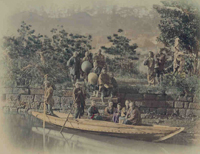Possibly Stillfried's work was more convincingly hand-coloured than that of Beato's, at least from the examples I have seen. He also had a number of Japanese assistants, who he taught to photograph in the same style as himself, the best known of these was Kimbei Kusakabe.
Many of the pictures taken in this period echoed the subject matter and the colours of the Japanese prints. Although the work of Beato and Stillfried remained resolutely European in character - and similar in its approach to much other photography of 'exotic' native cultures around the world, Kimbei - despite using similar techniques of staging his pictures often produces more authentically Japanese scenes, both in his groups and particularly in his landscapes.
One subject of particular fascination for Westerners were the Geisha, whose vocation as entertainers of men was public in a way that had no counterpart in the West, awarding them a high status in Japanese society. Although such pictures from Japan were relatively rare, as in many ethnographic studies, at least a part of this attraction was in the way that partially naked female forms could be viewed in a polite societies where women were kept covered from head to foot and a glimpse of ankle was considered daring.
There were similar opportunities for the display of female flesh in domestic scenes such as bath times. Different attitudes to nudity between Japan and the West perhaps persist to present times in the work of contemporary photographers.
The last of the great Western photographers to set up studios in Japan was Adolfo Farsari,(1841-1898), who came to Japan in 1873 and later set up a studio in Yokohama. In 1885 he took over von Stillfried's studio, with its negatives and 15 employees. Although he left Japan around 1890 his studios continued in business as the last Western owned photographers in Japan until at least 1917.
One of the great Victorian drawing-room entertainments was the stereo viewer, which first made an impact at the Great Exhibition in Hyde Park, London in 1851. A favourite subject for these were sets of photographs of distant countries showing their 'curiosities', including traditional dress, customs, buildings and landscape features, and Japan was well represented in these, both with work from the foreign residents and also various visitors to the country.
http://photography.about.com/library/weekly/aa052801b.htm

